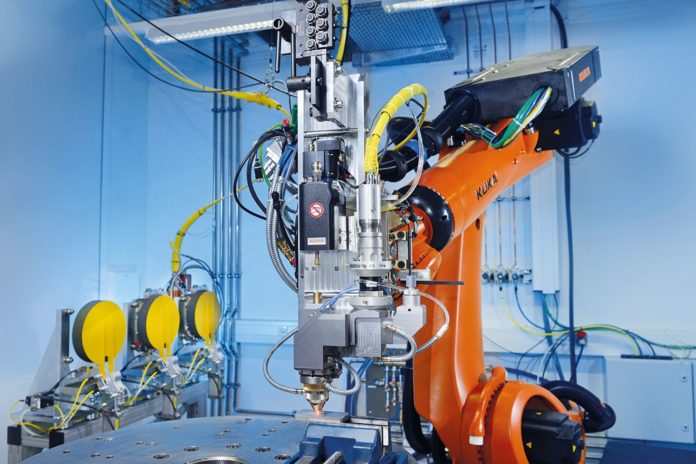MTU Aero Engines, Airbus, Mercedes-Benz, Fraunhofer ILT, KUKA and more join forces to develop an efficient hybrid additive manufacturing cell for the production of large metal components.
Named ProLMD, the collaborativeresearch project funded by the German Federal Ministry for Education and Research (BMBF) and has been launched four years ago.
Hybrid manufacturing process
This hybrid manufacturing process consists in combining conventional production methods, laser material deposition (LMD) and robotics into a modular cell which would be integrated into existing process chains.
Jan Bremer, a scientist at the Fraunhofer Institute for Laser Technology, states: “The aim was to develop economical and robust system technology for the LMD process, based on a jointed-arm robot, and to integrate it into a process chain for hybrid manufacturing. We are moving along the process chain for robot-based hybrid additive manufacturing and researching various technologies required for this. The spectrum of content covers everything – from processing heads, robot and shielding gas systems to welding processes, quality assurance and software.”
According to the partners, the process would be highly flexible since they are using both wire and metal powder as feedstock to open up further applications.
So far, we already know that Fraunhofer ILT has also developed a processing optic which can produce a ring beam for coaxial laser material deposition with a uniform intensity distribution. However, deposition rates in the range of 1 to 2 kg/h at high geometric resolution will be developed as part of the ProLMD project.
MTU Aero Engines has been leveraging LMD to add functional elements to traditionally manufactured engine components while Airbus has been reinforcing some of its components using 3D ribbing. Mercedes-Benz on the other hand, has adapted a press tool on its body production line to include an LMD tool head. Bought by KUKA, the cell that will be integrated into existing processes is a multi-axis robotic arm with an LMD toolhead.
According to Bremer, “these examples show what we understand by hybrid manufacturing. It is the flexible combination of advantages from different manufacturing processes, as it combines any conventional manufacturing process with LMD to form a continuous process chain.”
“In the test facility, we can use up to eight axes to access a component of almost any complexity from all sides. The machine technology can be implemented at an amazingly low cost by means of robots“, continues the scientist.
Remember, you can post free of charge job opportunities in the AM Industry on 3D ADEPT Media or look for a job via our job board. Make sure to follow us on our social networks and subscribe to our weekly newsletter : Facebook, Twitter, LinkedIn & Instagram ! If you want to be featured in the next issue of our digital magazine or if you hear a story that needs to be heard, make sure to send it to contact@3dadept.com






